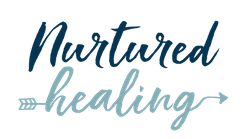Yesterday I managed to slam my right pointer finger in the house door. It was one of those pains where you don’t notice it at first, and then the throbbing begins, and it continues until you want to lose your mind. To help it heal, I iced it until it went numb several times and spent some time in front of the red light (more on this to come!).
Now the bruise is a visual reminder that “I made a mistake.” That I did something “wrong.” As a righty, the soreness sharply reminds me of this every time I grasp my pen to write something down or pick something up to complete my daily tasks. It’s easy to focus on this outcome of my miscalculated exit out of the house. If I do, it brings me straight back to incorrect thinking.
You see, I used to think there was something inherently wrong with me as if I was broken at birth. I always strived to do better, to be better, and to seek validation and approval for my efforts. It’s undeniable when I look back at my high school career and the roles I took on:
National Honor Society Member, with a heavy focus on my grade point average at all times;
Competitive Cheerleader at the Varsity level (even when I was in my younger years);
Student Council Vice President;
Active in clubs such as Yearbook and Students Against Drunk Driving (SADD);
Active in my church youth group;
Star student earning enough scholarships to cover my first year in college.
I thought that if I could just do more or achieve more, I would feel better. But that wasn’t the case. The more I achieved, the more I felt I needed to achieve in order to be seen and acknowledged, and those I was looking for approval from never gave it.
It took years to understand that the line of thinking and doing was a protection mechanism—adaptive responses to something that threatened my nervous system when I was young. I responded with perfectionism and people-pleasing.
Looking back, the people-pleasing is obvious. I said yes to everything despite having a full schedule and not getting the quality sleep I needed. I did not want to disappoint anyone because I felt that I would not get the approval I was seeking.
I also fit all the common traits of a perfectionist. I had a fear of failure. I set unrealistic expectations and was highly critical of myself and my outcomes. I also found myself procrastinating to avoid the potential for failure, being criticized, and not meeting those expectations or standards.
Once I learned about these adaptive patterns I established in order to “be loved,” it was a relief. It meant I could stop people-pleasing and perfectionist behavior. But how? They were both now habits that I had used in my everyday life. They felt like a part of me.
No Can Do
I started with the simplest thing I could think of—I said “no” more often. When a request arose, I checked in with myself. Did I want to do it? Support it? I had to sift underneath the feeling that I would disappoint others to feel and hear what I wanted. If my body said “no,” I said “no.”
It was uncomfortable at first, especially when it came to loved ones or friends making the request. But over time, it became easier. And today, it’s a vital part of my decision-making.
Ready Enough
Acting before I feel/felt ready has been more challenging for me, and the perfectionism pattern can still trip me up from time-to-time. It is a matter of checking my mindset and reframing as needed to overcome this pattern. In her book, “A Power of Your Own,” author and Nikki Groom sums it up perfectly when she says,
“You can decide you’re ready enough now and act accordingly.”
The more I “decide and act accordingly,” the more proof and feedback I get that I am on the right track. Even if my outcomes don’t go according to plan, I can treat the effort as an experiment and try another route. It’s been the most freeing feeling to realize that if something I experiment with is a flop, I can start over or find another way.
Healing Over Time
Just like our bodies have an innate ability to heal after a physical injury, I believe we can heal from our adaptive patterns. First, we need to consider that the patterns we established were specifically designed to protect us and keep us connected to our caregivers (no matter how off base this seems). We “heal” them by becoming aware that they exist and deciding if they serve us and our lives in the present.
In my case, both patterns mentioned, people-pleasing and perfectionism, were not supporting where I want(ed) to go. They were acting as a hindrance, keeping me busy with other people’s agendas and activities and stopping me from acting on my own.
I am not and never was broken. Over time these adaptive patterns developed into invisible bruises that kept me from playing full out because it was painful. They didn’t match with where I had evolved, and it was up to me to become aware and take steps to heal them.
What adaptive patterns do you notice in your life?
Are they stopping you from harnessing your potential?







